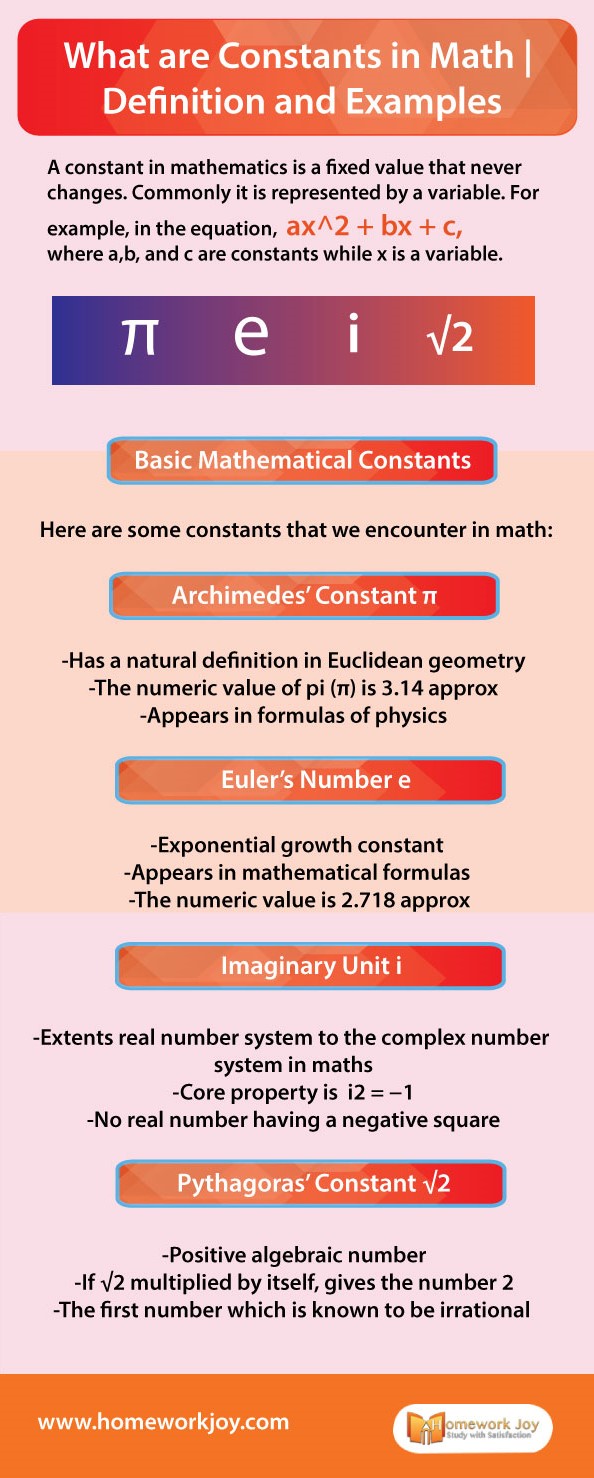A constant in mathematics is a fixed value that never changes. Commonly it is represented by a variable. For example, in the equation,
ax^2 + bx + c,
where a,b, and c are constants, and x is a variable.
So these mathematical constants are like symbols that can be used across multiple mathematical problems.
Basic Mathematical Constants
Here are some constants that we encounter in math:
Archimedes’ Constant π
“This mysterious 3.141592…, which comes in at every door and window, and down every chimney.” – Augustus De Morgan (1806-1871)
This constant is also known as Pi. In geometry, it is defined as the ratio of the circumference of a circle to its diameter. Archimedes of Syracuse proved that π is the ratio of an area enclosed by a circle to the square of its radius.
Euler’s Number e
Exponential growth is one of the most important constants in math. It is an irrational number thus cannot be written as a simple fraction. There are different ways to calculate the value of e. For example, the value of (1+1/n)^n gives e:
| n | (1+1/n)^n |
| 1 | 2.0000 |
| 2 | 2.25000 |
| 5 | 2.48832 |
Imaginary unit i
The imaginary unit is the solution to the quadratic equation. For example, x2 + 1 = 0. But there is no real number related to this constant in math. i is used to extending the real numbers to complex numbers. So there are two complex square roots of -1or -i, just as there are two square roots of every number other than zero. In disciplines like engineering, the imaginary unit is denoted by j instead of i.
Pythagoras’ Constant √2
Pythagoras’ constant is the first irrational number ever discovered. It is the square root of two. For investigating the diagonal of a square of side, Pythagoras’ constant is used. The decimal expansion of √2 is 1.4142135 approx.
Constants in Advanced Math
The following constants are part of advanced mathematics.
The Feigenbaum Constants α and δ
The name of these constants refers to mathematical physicist Mitchell Feigenbaum. These constants are mathematical invariants of logistics maps. Now you must be thinking, what is logistic mapping? So logistic mapping is a polynomial mapping that often explains the simple non-linear dynamical equations.
The numeric value of α = 2.5029
The numeric value of δ = 4.6692
The Golden Ratio φ
The golden ratio is mainly related to figures with pentagonal symmetry. As the length of the pentagonal’s diagonal is φ times its sides. Kepler proved that the golden ratio has the slowest convergence of any irrational number.
The numeric value of φ = 1.6180339 approx
Thus an understanding of these mathematical constants is essential to understand different equations their derivations. Furthermore, if you need more help related to math concepts, get instant math assignment help from our experts.
